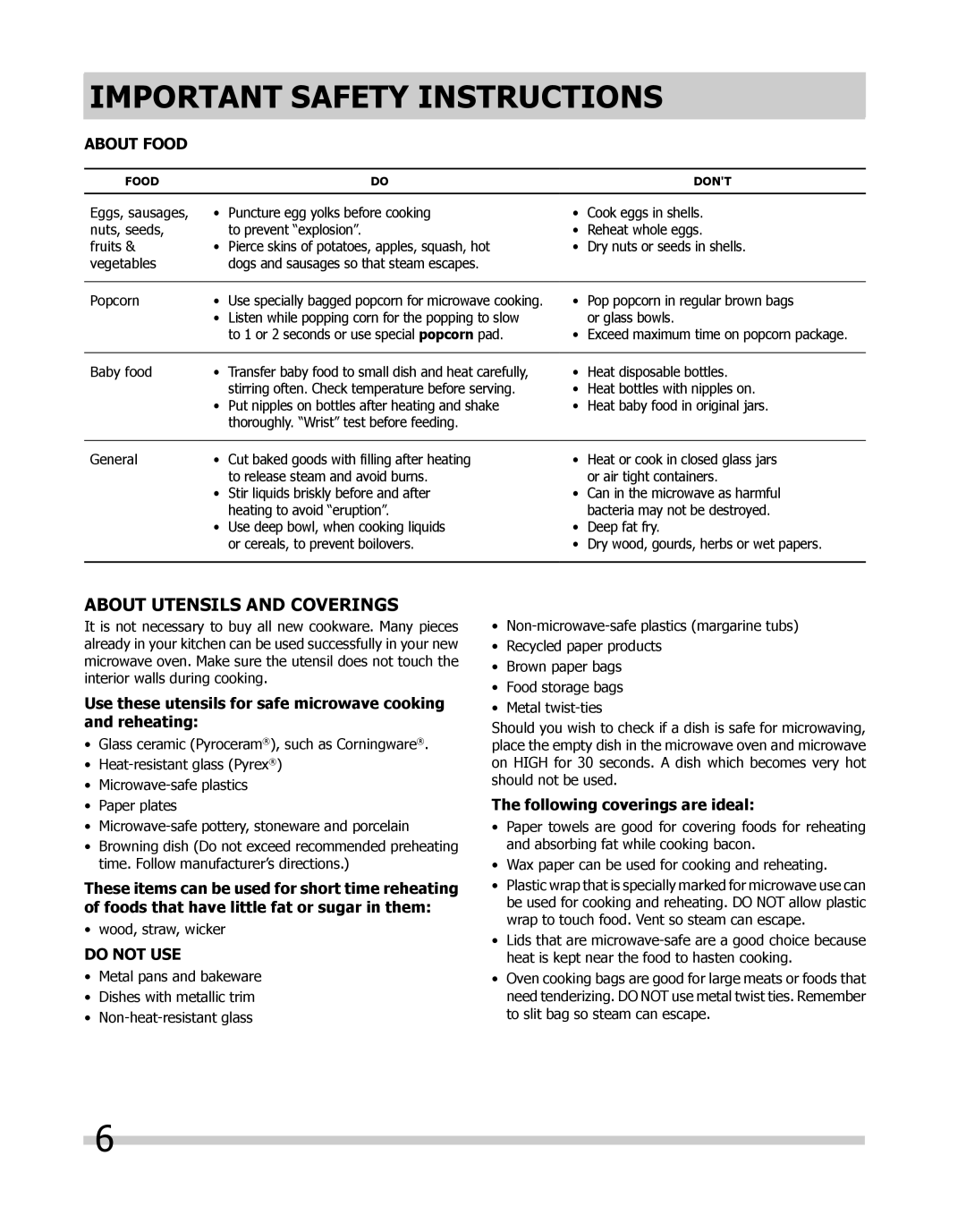
IMPORTANT SAFETY INSTRUCTIONS
About food
Food |
| Do |
| Don't |
|
|
|
|
|
Eggs, sausages, | • | Puncture egg yolks before cooking | • | Cook eggs in shells. |
nuts, seeds, |
| to prevent “explosion”. | • | Reheat whole eggs. |
fruits & | • | Pierce skins of potatoes, apples, squash, hot | • | Dry nuts or seeds in shells. |
vegetables |
| dogs and sausages so that steam escapes. |
|
|
Popcorn | • | Use specially bagged popcorn for microwave cooking. |
| • | Listen while popping corn for the popping to slow |
|
| to 1 or 2 seconds or use special popcorn pad. |
•Pop popcorn in regular brown bags or glass bowls.
•Exceed maximum time on popcorn package.
Baby food | • | Transfer baby food to small dish and heat carefully, | • | Heat disposable bottles. |
|
| stirring often. Check temperature before serving. | • | Heat bottles with nipples on. |
| • | Put nipples on bottles after heating and shake | • | Heat baby food in original jars. |
|
| thoroughly. “Wrist” test before feeding. |
|
|
General | • | Cut baked goods with filling after heating |
|
| to release steam and avoid burns. |
| • | Stir liquids briskly before and after |
|
| heating to avoid “eruption”. |
| • | Use deep bowl, when cooking liquids |
|
| or cereals, to prevent boilovers. |
•Heat or cook in closed glass jars or air tight containers.
•Can in the microwave as harmful bacteria may not be destroyed.
•Deep fat fry.
•Dry wood, gourds, herbs or wet papers.
About Utensils and Coverings
It is not necessary to buy all new cookware. Many pieces already in your kitchen can be used successfully in your new microwave oven. Make sure the utensil does not touch the interior walls during cooking.
Use these utensils for safe microwave cooking and reheating:
•Glass ceramic (Pyroceram®), such as Corningware®.
•
•
•Paper plates
•
•Browning dish (Do not exceed recommended preheating time. Follow manufacturer’s directions.)
These items can be used for short time reheating of foods that have little fat or sugar in them:
•wood, straw, wicker
DO NOT USE
•Metal pans and bakeware
•Dishes with metallic trim
•
•
•Recycled paper products
•Brown paper bags
•Food storage bags
•Metal
Should you wish to check if a dish is safe for microwaving, place the empty dish in the microwave oven and microwave on HIGH for 30 seconds. A dish which becomes very hot should not be used.
The following coverings are ideal:
•Paper towels are good for covering foods for reheating and absorbing fat while cooking bacon.
•Wax paper can be used for cooking and reheating.
•Plastic wrap that is specially marked for microwave use can be used for cooking and reheating. DO NOT allow plastic wrap to touch food. Vent so steam can escape.
•Lids that are
•Oven cooking bags are good for large meats or foods that need tenderizing. DO NOT use metal twist ties. Remember to slit bag so steam can escape.
6
